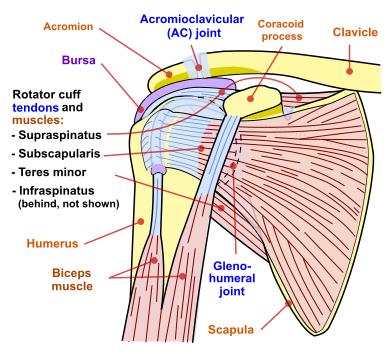Shoulder impingement syndrome
Editor-In-Chief: Prab R Tumpati, MD
Obesity, Sleep & Internal medicine
Founder, WikiMD Wellnesspedia &
W8MD medical weight loss NYC and sleep center NYC
| Shoulder impingement syndrome | |
|---|---|

| |
| Synonyms | Subacromial impingement, painful arc syndrome, supraspinatus syndrome, swimmer's shoulder, thrower's shoulder |
| Pronounce | N/A |
| Specialty | Orthopedics |
| Symptoms | Shoulder pain, weakness, reduced range of motion |
| Complications | N/A |
| Onset | Gradual |
| Duration | Varies |
| Types | N/A |
| Causes | Repetitive overhead activity, shoulder instability, muscle imbalance |
| Risks | Athletic activities, occupational hazards |
| Diagnosis | Physical examination, imaging studies |
| Differential diagnosis | Rotator cuff tear, adhesive capsulitis, bursitis |
| Prevention | N/A |
| Treatment | Physical therapy, NSAIDs, corticosteroid injections, surgery |
| Medication | N/A |
| Prognosis | Generally good with treatment |
| Frequency | Common in athletes and manual laborers |
| Deaths | N/A |
Shoulder Impingement Syndrome is a common condition affecting the shoulder joint. It is also known as Subacromial Impingement, Swimmer's Shoulder, Thrower's Shoulder, and Painful Arc Syndrome.
Causes
Shoulder Impingement Syndrome is caused by the tendons of the rotator cuff muscles becoming impinged as they pass through a narrow bony space in the shoulder called the subacromial space. This can cause pain, weakness and loss of movement at the shoulder.
Symptoms
The main symptoms of Shoulder Impingement Syndrome include:
- Pain in the shoulder and arm, which may be worse when lifting the arm, lying on it or during activities that require reaching overhead.
- Weakness of the shoulder muscles.
- Stiffness in the shoulder.
- Difficulty lifting objects, especially overhead.
- Pain at night, which can affect sleep.
Diagnosis
The diagnosis of Shoulder Impingement Syndrome is usually made based on the symptoms and a physical examination. However, further tests such as an X-ray, MRI or Ultrasound may be used to confirm the diagnosis and rule out other conditions.
Treatment
Treatment for Shoulder Impingement Syndrome usually involves a combination of rest, physiotherapy, pain relief and sometimes surgery. The aim of treatment is to reduce pain and inflammation, and to restore normal function to the shoulder.
Prevention
Prevention of Shoulder Impingement Syndrome can often be achieved through regular exercise to strengthen the shoulder muscles, good posture, and avoiding activities that cause pain.
See Also
References
Transform your life with W8MD's budget GLP-1 injections from $125.
W8MD offers a medical weight loss program to lose weight in Philadelphia. Our physician-supervised medical weight loss provides:
- Most insurances accepted or discounted self-pay rates. We will obtain insurance prior authorizations if needed.
- Generic GLP1 weight loss injections from $125 for the starting dose.
- Also offer prescription weight loss medications including Phentermine, Qsymia, Diethylpropion, Contrave etc.
NYC weight loss doctor appointments
Start your NYC weight loss journey today at our NYC medical weight loss and Philadelphia medical weight loss clinics.
- Call 718-946-5500 to lose weight in NYC or for medical weight loss in Philadelphia 215-676-2334.
- Tags:NYC medical weight loss, Philadelphia lose weight Zepbound NYC, Budget GLP1 weight loss injections, Wegovy Philadelphia, Wegovy NYC, Philadelphia medical weight loss, Brookly weight loss and Wegovy NYC
|
WikiMD's Wellness Encyclopedia |
| Let Food Be Thy Medicine Medicine Thy Food - Hippocrates |
Medical Disclaimer: WikiMD is not a substitute for professional medical advice. The information on WikiMD is provided as an information resource only, may be incorrect, outdated or misleading, and is not to be used or relied on for any diagnostic or treatment purposes. Please consult your health care provider before making any healthcare decisions or for guidance about a specific medical condition. WikiMD expressly disclaims responsibility, and shall have no liability, for any damages, loss, injury, or liability whatsoever suffered as a result of your reliance on the information contained in this site. By visiting this site you agree to the foregoing terms and conditions, which may from time to time be changed or supplemented by WikiMD. If you do not agree to the foregoing terms and conditions, you should not enter or use this site. See full disclaimer.
Credits:Most images are courtesy of Wikimedia commons, and templates, categories Wikipedia, licensed under CC BY SA or similar.
Translate this page: - East Asian
中文,
日本,
한국어,
South Asian
हिन्दी,
தமிழ்,
తెలుగు,
Urdu,
ಕನ್ನಡ,
Southeast Asian
Indonesian,
Vietnamese,
Thai,
မြန်မာဘာသာ,
বাংলা
European
español,
Deutsch,
français,
Greek,
português do Brasil,
polski,
română,
русский,
Nederlands,
norsk,
svenska,
suomi,
Italian
Middle Eastern & African
عربى,
Turkish,
Persian,
Hebrew,
Afrikaans,
isiZulu,
Kiswahili,
Other
Bulgarian,
Hungarian,
Czech,
Swedish,
മലയാളം,
मराठी,
ਪੰਜਾਬੀ,
ગુજરાતી,
Portuguese,
Ukrainian
Contributors: Prab R. Tumpati, MD





